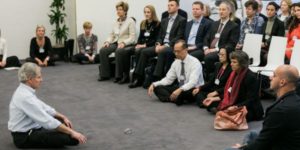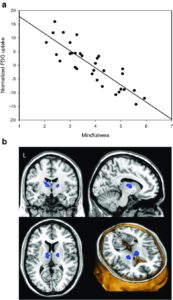By John M. de Castro, Ph.D.
“A large part of being a human being is having social, emotional and attention skills and in the majority of schools I visit, we don’t actually teach kids how to pay attention or how to deal with their inner states in a healthy way. We just assume that they’ll learn them somewhere else.” – Patrick Cook-Deegan
It’s a normal human response to become anxious while being evaluated by others. In fact, the vast majority of students report that the stress and anxiety associated with being evaluated is greater than that produced by anything else in their lives. The majority of students are able to cope with the anxiety and perform on tests in spite of it. But, for a minority of students, somewhere around 16%-20%, the anxiety level is so high that it causes them to “freeze” on tests and markedly impair their performance. It is estimated that they perform 12 points lower, more than one letter grade, on average than students lower in anxiety. Counselling centers in colleges and universities report that evaluation anxiety is the most common complaint that they treat among students.
It has been demonstrated repeatedly that mindfulness counteracts anxiety and mindfulness training is an effective treatment for a variety of forms of anxiety. Mindfulness training has been shown to be effective for anxiety disorders in general and in relieving test anxiety. Mindfulness-Based Stress Reduction (MBSR) is a classic program that includes three mindfulness techniques; meditation, body scan, and yoga. MBSR has been employed for years to successfully treat a myriad of psychological and medical conditions. But, it has not yet been tested for use to treat test anxiety.
In today’s Research News article “Effectiveness of mindfulness-based stress reduction on emotion regulation and test anxiety in female high school students.” (See summary below or view the full text of the study at: https://www.ncbi.nlm.nih.gov/pmc/articles/PMC5651652/ ),
Shahidi and colleagues recruited female High School students and randomly assigned them to a no-treatment control condition or to receive an 8-week, once a week for 90 minutes, program of Mindfulness-Based Stress Reduction (MBSR) with encouragement to practice at home. They were measured before and after training and 3-months later for test anxiety and emotion regulation.
They found that after the program and also 3-months later that the students who received MBSR had clinically significant 46% reductions in test anxiety. In addition, they showed significant improvement in emotion regulation including; blaming others, rumination/focus on thought, catastrophizing, putting into perspective, positive refocusing, positive reappraisal, acceptance, and refocus on planning. Only the self-blame strategy was not significantly affected by MBSR training. Hence, MBSR training for High School students produces a lasting relief of test anxiety and improves the ability to cope with emotions.
It should be mentioned that this study did not contain an active control condition. So, bias and contamination of the results may be present. Also, the study only tested female students, thus limiting generalization of the results. Future research should include a both males and females and a group receiving active alternative treatment, say exercise training. Regardless, the results suggest that MBSR training can help students cope with their emotions, including test anxiety. This would predict that there would be improved academic performance and less psychological problems in the trained students. This further suggests that MBSR training should be considered to be routinely employed for High School students.
So, improve the emotion regulation of high school students with mindfulness.
“Mindfulness practices help children improve their ability to pay attention, by learning to focus on one thing (e.g., breath, sound) while filtering out other stimuli. Mindfulness also provides kids with skills for understanding their emotions and how to work with them.” – Sarah Beach
CMCS – Center for Mindfulness and Contemplative Studies
This and other Contemplative Studies posts are also available on Google+ https://plus.google.com/106784388191201299496/posts and on Twitter @MindfulResearch
Study Summary
Shokooh Shahidi, Hossein Akbari, Fatemeh Zargar, Effectiveness of mindfulness-based stress reduction on emotion regulation and test anxiety in female high school students. J Educ Health Promot. 2017; 6: 87. Published online 2017 Oct 4. doi: 10.4103/jehp.jehp_98_16
Abstract
BACKGROUND:
Test anxiety is one of the most disabling disorders and annual school academic performance will affect millions of students. Hence, it needs attention and treatment. Therefore, this research aimed to examine the effectiveness of a mindfulness-based stress reduction (MBSR) therapy on emotion regulation and test anxiety of students and test the remaining effect of this treatment after 3 month.
METHODS:
Sample size of fifty participants randomly divided into experimental (MBSR) and control groups. The MBSR training interventions were implemented to the experimental group, in eight weekly sessions using MBSR manual by John Kabat-Zinn (2013). Participants in both groups were evaluated using the Test Anxiety Scale and the Cognitive Emotion Regulation Questionnaire. The study findings were analyzed using analysis of variance with repeated measures.
RESULTS:
The result shows that the MBSR program has had continuous significant effects on test anxiety (P< 000) and emotion regulation (P < 000) but was not significant only for the self-blame subscale (P = 0.126).
CONCLUSIONS:
The study results indicated that the effects of MBSR lasted through the follow-up, for both of these variables. Using the results of this study may be proposed school counselors use mindfulness to reduce the anxiety of their pupils.









